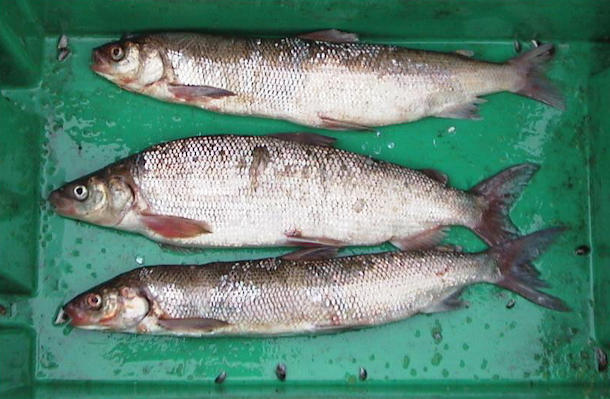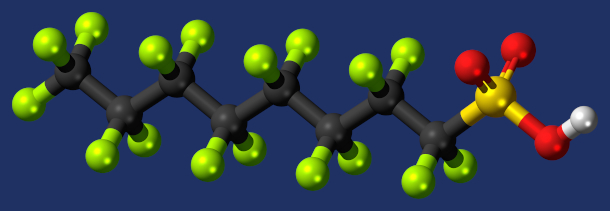High Levels of PFAS in Wild Freshwater Fish
Air Date: Week of February 17, 2023

Whitefish from Lake Michigan, one of the Great Lakes whose fish population was found to be highly contaminated by PFAS. (Photo: NOAA Great Lakes Environmental Research Laboratory)
PFAS “forever” chemicals have widespread health impacts from cancers to reproductive disorders. A recent study revealed high levels of PFAS in wild-caught, American freshwater fish. David Andrews, a senior scientist with the Environmental Working Group, joined Living on Earth’s Bobby Bascomb to discuss the results and the impact on consumers.
Transcript
CURWOOD: Per and polyfluorinated substances commonly called PFAS are chemicals commonly used in everything from fast food wrappers and cookware to firefighting foam and carpeting. Decades of research indicates that PFAS are harmful to human health, with risks ranging from cancers to reproductive disorders to immune function disruption. And a recent study published in Environmental News, showed that wild-caught, American freshwater fish are often loaded with PFAS. Living on Earth’s Bobby Bascomb spoke with David Andrews, a senior scientist with the Environmental Working Group.
ANDREWS: So this is a study where we were looking for how are people being exposed to these chemicals. We know there's health concerns at very low concentrations. There have been a number of scientific studies that have shown that people who eat more fish have slightly higher levels of PFAS in their serum. But we wanted to kind of dive in and see what's the picture look like across the United States. Actually, we were very surprised to find that there were publicly available data sets. This is testing that had been conducted by the US Environmental Protection Agency, the most recent data was 2013 to 2015. But they actually took a random sample of streams and rivers across the country trying to get a representative sample of PFAS levels in freshwater fish across the country. And then there is also another set of data that — collected by the agency — where they sampled across the whole U.S. shoreline of the Great Lakes. So they're these two great data sets, they're actually 500 different sample locations. And these are fish that are important to anglers. And so this huge data set was something that we looked at in terms of how much PFAS are in these fish. And the results were really quite striking. compared to any other source of PFAS exposure. The levels in these fish are incredibly high and in the 10s of 1000S of parts per trillion.
.jpg)
A warning advising people who fish at Ford Lake, Michigan to not eat their catches due to the high levels of PFAS contamination. (Photo: Notorious4life, Wikimedia Commons)
BASCOMB: How does that compare to other forms of exposure, You know, from household products or water. People are very concerned about PFAS and water. How does the PFAS found in fish compared to other ways that people might be exposed?
ANDREWS: As far as I know this is likely the highest source of exposure for anyone who consumes these fish. And that's where it really stands out. What's been in the news, I guess recently in particular is PFAS contamination of drinking water for good reason. It's easy to test for there are methods to remove it from drinking water. And in a number of states as well as the federal government have set or are in the process of setting drinking water standards. But those drinking water standards are in the low parts per trillion in the levels in fish were 1000s to 10s of 1000s of times higher. And that's what really is quite striking. And we actually made a comparison showing that consuming a single fish serving, and these are freshwater wild caught or locally caught fish, would be equivalent to drinking over a month of contaminated drinking water.
BASCOMB: Wow, that's really concerning then. And I understand that you actually compared freshwater fish to grocery store fish, which is mostly farmed and ocean species. What were your findings there?
ANDREWS: So the Food and Drug Administration has done some testing of the food supply, which is actually really important, we believe they should be doing more testing still. But the testing they've done to date over the past three or four years has actually shown very low levels of PFAS contamination compared to these freshwater fish samples. We compared fish samples collected by the Food and Drug Administration. So these are grocery stores samples of fish that included both saltwater and marine fish, such as salmon, tuna, as well as farmed fish such as tilapia and catfish. And across the board, those levels were relatively similar, and on average, about 300 times lower than the concentration of PFAS and freshwater fish. So an incredible difference in potential exposure. We still think people should be consuming fish. Fish is the healthy source of protein. But when possible, these grocery store fish had much, much lower levels of contamination. And we actually think that you should switch to those.

A ball and stick model of the chemical structure of PFOS, the polyfluoroalkyl cousin of PFAS chemicals. (Photo: Jynto, Wikimedia Commons)
BASCOMB: Well, many low income communities and people in the developing world depend on fish as a good source of protein. And we're always told that you know, fish is very healthy for us. Can you tell us more about that, please? And how concerning this is for communities that really depend on fish for their food.
ANDREWS: There was actually a study done by the New York State Department of Health that looked at a Burmese and Karen immigrant population who are consuming a lot of locally caught fish. And that study showed that in this population that was catching their own fish and eating it, their blood serum levels of PFAS were significantly above what's seen in the general population. So this is very concerning for communities that rely on fish for subsistence. And then this is something that we actually highlighted in the study as being a particular concern in a place where we think there needs to be national action because there are people who go out and catch fish for food and in particular freshwater fish. And there's also other groups that rely on fish for social and cultural reasons. And the concern is that these communities, often times they are marginalized communities, are those who don't have the income to replace locally caught fish with fish from the grocery store. They may have the highest exposures in the most impact from this contamination. And ultimately, I think it points to the need to really hold polluters accountable for this and come up with have a way to either drive cleanup of this which there are no easy solutions for or or somehow supply alternative sources of protein that are not contaminated to these groups.
BASCOMB: Well, we know very well that PFAS chemicals are a problem, we now understand that they're in freshwater and endangering fish and wildlife and ourselves. What can be done about it? Can it be removed in some way? Sounds expensive. But I mean, what are the next steps now that we know this is such an issue?
ANDREWS: There’s no easy way to remove these chemicals from waterways or from contaminated fish. And that's what's really frustrating in some ways. But it also points the need for immediate action to not make this worse, not continue the contamination. So we're calling for industry and the federal government to turn off the tap on ongoing contamination and end industrial releases of these chemicals into the environment and make sure that it's more strictly regulated. We also think that non essential uses of PFAS should be eliminated. So these chemicals have found their way into 100s and 1000s of different products. This is everything from fast food wrappers, to clothing, to products all around the house. And many of those uses are just completely unnecessary. I was actually a co-author on another paper that came out this week, establishing a framework for how we can eliminate non-essential uses of chemicals, and replace the current regulatory system. I mean, that would be a big change. But I think that the extent of this contamination in the scope of the problem really highlights the need for an entire change in how chemicals are regulated and how we deal with concerning chemicals, chemicals that that can cause such harmful impact on our bodies.

McDonald’s, one of the fast-food companies found to use PFAS in their packaging, vowed to stop using PFAS chemicals entirely by 2025. (Photo: Famartin, Wikimedia Commons)
BASCOMB: So the first thing we need to do is turn off the tap.
ANDREWS: Correct, that's the first thing we need to do is and ongoing releases into the environment. And we actually know this does help few PFAS chemicals. In particular PFOS used to make scotchguard and PFOA, a primary ingredient in producing Teflon, were phased out of the market starting in 2005, and over a 10 or 15 year period that their use in products in the United States has decreased significantly. And we're seeing levels of those contaminants go down in the environment as well as in fish. So that is a positive sign that shows that when these chemicals are no longer produced and put into products, that the concentration does go down over time, even though these are forever chemicals, the concentrations that we see in measuring the environment decrease. But there are a whole host, as we mentioned over 1000 of these chemicals that have been approved for use. And so the scope is much bigger than just a few chemicals that have been restricted to date.
BASCOMB: So do particular species of fish accumulate more PFAS chemicals than others? I mean, do we know that and you know, what kind of advice can you give to listeners who are you know, maybe waiting for summer to roll around so they can get back on the water and go fishing? How can they be safe when they go to you know, maybe put that fish in the frying pan at the end of the day.
ANDREWS: So we didn't see any differences between different species. And I will say we didn't we didn't pursue that avenue of analysis very far. But in other studies had been have been done. There's no real clear pattern of which fish have higher levels of PFAS contamination. So that is really quite interesting. And in some ways also a little bit frustrating too as a fisherman there's you don't know what what to try to catch that maybe safer. And ultimately, I think that points towards our one of our recommendations is that there should be consistent fish consumption advice across the country. There are currently 14 states that have specific fish consumption advice for PFAS, but it's not consistent, then we think that Americans, anglers across the country should get consistent advice from the government in terms of what is the safe exposure level. But ultimately from this analysis, we think that people who are going out fishing for freshwater fish that they consider catch and release and if possible, replacing that fish with a grocery store caught fish. I think that needs to occur until levels have come down. There's greater testing showing that contamination would not be a health concern, not the answer I want to give, but it's the answer that really comes out of this analysis.
CURWOOD: David Andrews, a senior scientist with the Environmental Working Group speaking with Living on Earth’s Bobby Bascomb.
Links
Learn more about how the EPA plans to address PFAS in the water system
Learn about the Environmental Working Group’s work regarding PFAS
Living on Earth wants to hear from you!
Living on Earth
62 Calef Highway, Suite 212
Lee, NH 03861
Telephone: 617-287-4121
E-mail: comments@loe.org
Newsletter [Click here]
Donate to Living on Earth!
Living on Earth is an independent media program and relies entirely on contributions from listeners and institutions supporting public service. Please donate now to preserve an independent environmental voice.
NewsletterLiving on Earth offers a weekly delivery of the show's rundown to your mailbox. Sign up for our newsletter today!
 Sailors For The Sea: Be the change you want to sea.
Sailors For The Sea: Be the change you want to sea.
 The Grantham Foundation for the Protection of the Environment: Committed to protecting and improving the health of the global environment.
The Grantham Foundation for the Protection of the Environment: Committed to protecting and improving the health of the global environment.
 Contribute to Living on Earth and receive, as our gift to you, an archival print of one of Mark Seth Lender's extraordinary wildlife photographs. Follow the link to see Mark's current collection of photographs.
Contribute to Living on Earth and receive, as our gift to you, an archival print of one of Mark Seth Lender's extraordinary wildlife photographs. Follow the link to see Mark's current collection of photographs.
 Buy a signed copy of Mark Seth Lender's book Smeagull the Seagull & support Living on Earth
Buy a signed copy of Mark Seth Lender's book Smeagull the Seagull & support Living on Earth

